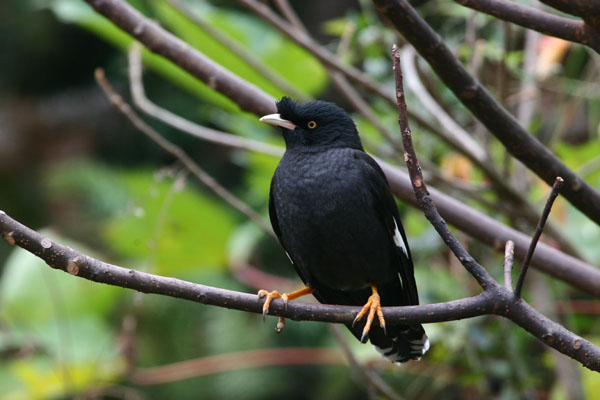Acridotheres cristatellus
IUCN
LCBasic Information
Scientific classification
- name:Acridotheres cristatellus
- Scientific Name:Acridotheres cristatellus,Crested Myna,Black starling, thrush, cold starling, crested starling, liaogezi
- Outline:Songbird
- Family:Passeriformes Sturnidae Myna
Vital signs
- length:23-28cm
- Weight:78-150g
- lifetime:8~12years
Feature
A popular caged bird that can imitate the calls of other birds and simple human speech.
Distribution and Habitat
In China, it is found in the Huaihe River Basin and areas south of it, including Taiwan Island and Hainan Island. Introduced populations in Beijing and other places have been growing in recent years. Abroad, it is distributed in the northern part of the Indochina Peninsula, and introduced populations are found in the Philippines, Borneo and North America.
They often live in clusters in the forest edge thickets of broad-leaved forests, bamboo forests and artificial forests. They are also found in forest clearings, farmlands, parks, nurseries, villages and other habitats. They are lively and noisy, and are not very afraid of people.
Appearance
The whole body is black and less shiny, with a cluster of short feathers on the forehead, the base of the primary flight feathers is white and forms a distinct block of wing spots, the undertail coverts have black and white horizontal stripes, and the tip of the tail feathers has white edges. It is similar to the forest starling, but the bill is light yellow and the undertail coverts are mottled. The iris is orange-red, the beak teeth are yellow with a red base, and the feet are dark yellow.
Details
Starlings are common in southern my country. They are not only important agricultural and forestry birds, but also popular caged birds. They can imitate the calls of other birds and simple human speech. They are widely caged in China and have been introduced to the Philippines and Canada.

They like to gather in groups, often standing on the backs of buffaloes, or gathering on big trees, or standing in rows on the ridges of roofs. At dusk, they often fly in large groups in the sky, and roost after making noises for a while. They sleep in bamboo forests, big trees or reeds at night, and roost in mixed groups with other starlings.
Often forage in plowed farmland, or stand on the backs of cattle, pigs and other livestock to eat parasites. Active, active in groups, sometimes in large groups, especially in the evening, in large groups to spend the night in trees. The night roosting place is relatively fixed, often active and foraging on the ground nearby, and only fly to the night roosting place at dusk. Good at singing, especially in the evening is very noisy.

Wild starlings have a mixed diet, mainly feeding on insects and insect larvae such as locusts, grasshoppers, beetles, snakes, caterpillars, cutworms, flies, lice, etc., as well as plant foods such as grains, plant fruits and seeds. They often follow farmers and oxen to peck at earthworms, insects, worms, etc. that are plowed out of the soil. They also like to peck at horseflies, flies and ticks on the backs of cattle, and also prey on locusts, beetles, mole crickets, etc. Most of the plant foods of starlings are various plants and weed seeds, as well as figs and vegetable stems and leaves.
The breeding season is from April to August. They nest in tree holes and building caves, which are lined with grass roots, grass stems, grass leaves, vines, feathers, debris, snake skin, plastic film, etc. The nest has no fixed shape. Sometimes they also nest in small groups.








